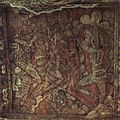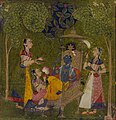Indian painting
This article needs attention from an expert in Visual arts. Please add a reason or a talk parameter to this template to explain the issue with the article. |

Indian painting is a form of Indian art.
Prelude
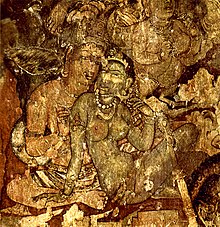
The earliest Indian paintings were the rock paintings of pre-historic times, the petroglyphs as found in places like Bhimbetka, and some of them are older than 5500 BC. Such works continued and after several millennia, in the 7th century, carved pillars of Ellora, Maharashtra state present a fine example of Indian paintings, and the colors, mostly various shades of red and orange, were derived from minerals. Thereafter, frescoes of Ajanta and Ellora Caves appeared. India’s Buddhist literature is replete with examples of texts which describe that palaces of kings and aristocratic class were embellished with paintings, but they have largely not survived. But, it is believed that some form of art painting was practiced during that time.
Miniature painting
In western India from the 16th to 18th century miniature painting developed. These small paintings were part of manuscripts written at the time and illustrate the subjects of the manuscripts.
Madhubani painting
Madhubani painting is a style of uttradi mutt painting, practiced in the Mithila region of Bihar state, India. The origins of Madhubani painting are shrouded in antiquity, and a tradition states that this style of painting originated at the time of the Ramayana, when King Janak commissioned artists to do paintings at the time of marriage of his daughter, Sita, with Sri Rama who is considered to be an incarnation of the Hindu god lord Vishnu.
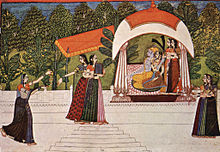
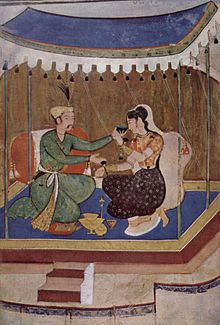
Rajput painting
Rajput painting, a style of Indian painting, evolved and flourished, during the 18th century, in the royal courts of Rajputana, India. Each Rajput kingdom evolved a distinct style, but with certain common features. Rajput paintings depict a number of themes, events of epics like the Ramayana and the Mahabharata, Krishna’s life, beautiful landscapes, and humans. Miniatures were the preferred medium of Rajput painting, but several manuscripts also contain Rajput paintings, and paintings were even done on the walls of palaces, inner chambers of the forts, havelies, particularly, the havelis of Shekhawait.
The colours extracted from certain minerals, plant sources, conch shells, and were even derived by processing precious stones, gold and silver were used. The preparation of desired colours was a lengthy process, sometimes taking weeks. Brushes used were very fine.
Mughal painting
Mughal painting is a particular style of Indian painting, generally confined to illustrations on the book and done in miniatures, and which emerged, developed and took shape during the period of the Mughal Empire 16th -19th centuries). Mughal paintings were a unique blend of Indian, Persian and Islamic styles. Because the Mughal kings wanted visual records of their deeds as hunters and conquerors, their artists accompanied them on military expeditions or missions of state, or recorded their prowess as animal slayers, or depicted them in the great dynastic ceremonies of marriages ...
Akbar (1556-1605) was the one who started encouraging of Mughal artista. After he had consolidated his political power, he built a new capital at Fatehpur Sikri where he collected artists from India and Persia . More than a hundred painters were employed, most of whom were Hindus from Gujarat, Gwalior and Kashmir.. They worked under the two Persian master-artists Abdus Samad and Mir Sayyid Ali, but they were encouraged and inspired by Akbar.
The stories of Amir Hamza, an uncle of the Prophet, were illustrated by Mir Sayyid Ali. The paintings of the Hamza-nama are of large size, 20 x 27" and were painted on cloth. They are in the Persian safavi style. Brilliant red, blue and green colours predominate; the pink, eroded rocks and the vegetation, planes and blossoming plum and peach trees are reminiscent of Persia . However, Indian tones appear in later work, when Indian artists were employed.
After him, Jehangir encouraged artists to paint portraits and durbar scenes. His most talented portrait painters were Abul Hasan and Bishan Das.
Shah Jehan (1627-1658) continued the patronage of painting. Some of the famous artists of the period were Mohammad Faqirullah Khan, Mir Hashim, Muhammad Nadir, Bichitr, Chitarman, Anupchhatar, Manohar and Honhar.
Aurangzeb had no taste for fine arts. Due to lack of patronage artists migrated to Hyderabad in the Deccan and to the Hindu states of Rajasthan in search of new patrons.
Mysore painting

Mysore painting is an important form of classical South Indian painting that originated in the town of Mysore in Karnataka. These paintings are known for their elegance, muted colours, and attention to detail. The themes for most of these paintings are Hindu Gods and Goddesses and scenes from Hindu mythology. In modern times, these paintings have become a much sought after souvenir during festive occasions in South India.

The process of making a Mysore painting involves many stages. The first stage involves the making of the preliminary sketch of the image on the base. The base consists of cartridge paper pasted on a wooden base. A paste made of Zinc oxide and Arabic gum is made called "gesso paste". With the help of a thin brush all the jewelery and parts of throne or the arch which have some relief are painted over to give a slightly raised effect of carving. This is allowed to dry. On this thin gold foil is pasted. The rest of the drawing is then pasted using watercolour. Only muted colours are used.
Tanjore painting
Tanjore painting is an important form of classical South Indian painting native to the town of Tanjore in Tamil Nadu. The art form dates back to the early 9th century, a period dominated by the Chola rulers, who encouraged art and literature. These paintings are known for their elegance, rich colours, and attention to detail. The themes for most of these paintings are Hindu Gods and Goddesses and scenes from Hindu mythology. In modern times, these paintings have become a much sought after souvenir during festive occasions in South India.
The process of making a Tanjore painting involves many stages. The first stage involves the making of the preliminary sketch of the image on the base. The base consists of a cloth pasted over a wooden base. Then chalk powder or zinc oxide is mixed with water-soluble adhesive and applied on the base. To make the base smoother, a mild abrasive is sometimes used. After the drawing is made, decoration of the jewellery and the apparels in the image is done with semi-precious stones. Laces or threads are also used to decorate the jewellery. On top of this, the gold foils are pasted. Finally, dyes are used to add colours to the figures in the paintings.
Bengal school
The Bengal School of Art was an influential style of art that flourished in India during the British Raj in the early 20th century. It was associated with Indian nationalism, but was also promoted and supported by many British arts administrators.
The Bengal school arose as an avant garde and nationalist movement reacting against the academic art styles previously promoted in India, both by Indian artists such as Ravi Varma and in British art schools. Following the widespread influence of Indian spiritual ideas in the West, the British art teacher Ernest Binfield Havel attempted to reform the teaching methods at the Calcutta School of Art by encouraging students to imitate Mughal miniatures. This caused immense controversy, leading to a strike by students and complaints from the local press, including from nationalists who considered it to be a retrogressive move. Havel was supported by the artist Abanindranath Tagore, a nephew of the poet Rabindranath Tagore. Tagore painted a number of works influenced by Mughal art, a style that he and Havel believed to be expressive of India's distinct spiritual qualities, as opposed to the "materialism" of the West. Tagore's best-known painting, Bharat Mata (Mother India), depicted a young woman, portrayed with four arms in the manner of Hindu deities, holding objects symbolic of India's national aspirations. Tagore later attempted to develop links with Japanese artists as part of an aspiration to construct a pan-Asianist model of art.
The Bengal school's influence in India declined with the spread of modernist ideas in the 1920s.
Modern Indian Painting
During the colonial era, Western influences started to make an impact on Indian art. Some artists developed a style that used Western ideas of composition, perspective and realism to illustrate Indian themes. Others, like Jamini Roy, consciously drew inspiration from folk art.
By the time of Independence in 1947, several schools of art in India provided access to modern techniques and ideas. Galleries were established to showcase these artists. Modern Indian art typically shows the influence of Western styles, but is often inspired by Indian themes and images. Major artists are beginning to gain international recognition, initially among the Indian diaspora, but also among non-Indian audiences.
The Progressive Artist's Group, established shortly after India became independent in 1947, was intended to establish new ways of expressing India in the post-colonial era. The founders were six eminent artists - K. H. Ara, S. K. Bakre, H. A. Gade, M.F. Husain, S.H. Raza and F. N. Souza, Though the group was dissolved in 1956, it was profoundly influential in changing the idiom of Indian art. Almost all India's major artists in the 1950s were associated with the group. Some of those who are well-known today are Bal Chabda, V. S. Gaitonde, Krishen Khanna, Ram Kumar, Tyeb Mehta, and Akbar Padamsee. Art historians like Prof. Rai Anand Krishna have also referred to those works of modern artistes that reflect Indian ethos. Some of the new artists like Geeta Vadhera have had acclaim in translating complex, Indian spiritual themes into the canvas - Sufi thought [1], Upanishads and the Bhagwad Geeta, for example.
Since the 1980s Indian artists started showing more vitality and variety in their work. Many of the new generation of artists have come from various fields in to art world and thus they bring with them newer concepts and styles. Devajyoti Ray had introduced in the early 1990s a new ism of art called Pseudo-realism. Again Jitish Kallat mixed graphic art with prints to develop a mode of expression which was hitherto not been used. vagaram choudhary work in new experimenting medium with 3D visuals. The other famous artists like Prakash Karmokar, Jahar Dasgupta, Bihon Choudhuri, Jogen choudhuri, vagaram choudhary and many others are enriching the modern art for India and their journey is still going on.
Samikshavad
Samikshavad is the first indigenous movement of art in modern India, which started in north India in 1974. It has a different identity from the western movements of art. It is neither affected or inspired by the top western art. It's main source of inspiration are the present social, political, cultural and economical conditions. Its aim is to make the Art free from personalized obligations and to socialize it, to change the art from mystery to something having special aim. A few of the artists who were inspired by this movement were Ravindra Nath Mishra, Hridya Narayan Mishra, Santosh Kumar Singh, Virendra Prasad Singh, Ram Shabd Singh, Raghuvir Sen Dhir, Ved Prakash Mishra, Gopal Madhukar Chaturvedi, Bala Dutt Pandey etc. Prof. Ram Chandra Shukla, professor and head of the department, of Painting at Banaras Hindu University, Varanasi, at that time, was the initiator and the main source of inspiration for this movement.
Some notable Indian paintings
This article needs additional citations for verification. (April 2007) |
- Hemen Majumdar's "Lady with the Lamp"
- Ravindranath Tagore's "Self portrait"
- Ramkinker Baij's "Jakkha 0 Jakkhi"
- Bikash Bhattacharya's "Doll-series"
- Geeta Vadhera's Jogia "Dhoop series" [1]
- MF Hussain's "Horses-series"
- Jamini Roy's "Jesus"
- Jainul Abedin's "Series on Bengal Famine"
- Sunil Das's "Bull Series"
- Devajyoti Ray's "In Despair"
- Tyeb Mehta's "Mahisasur"
- Fine Artist Rahul Deshpande
- B.G. Sharma's Krishna miniatures [2][3]
- Vagaram chudhary"Around The Cultural Elements"[4]
See also
External links
- Offbeat Art Exhibitions in India
- [5]
- The Arts Trust - Indian Art Gallery
- Indian art school Kalaamandir
- Indian arts
- A brief History of Indian Art since 2500BC till date
- Online exhibition from the Virginia Museum
- Mukul Dey Archives
- Metmusuem.org

